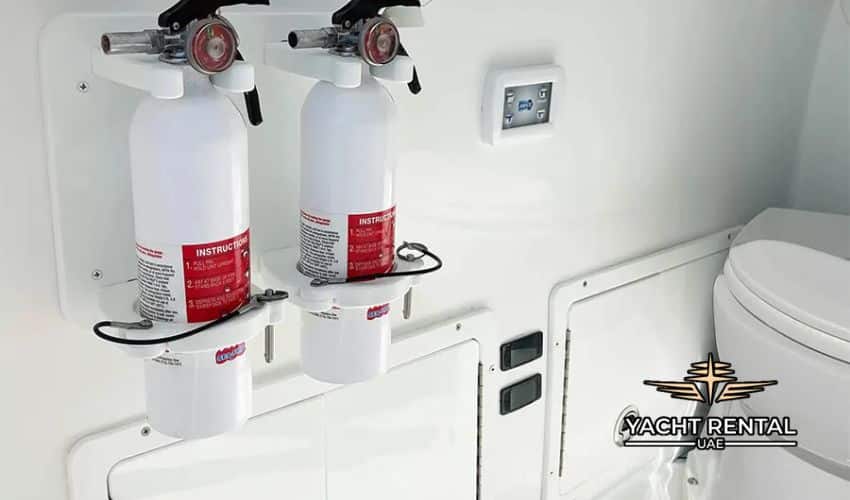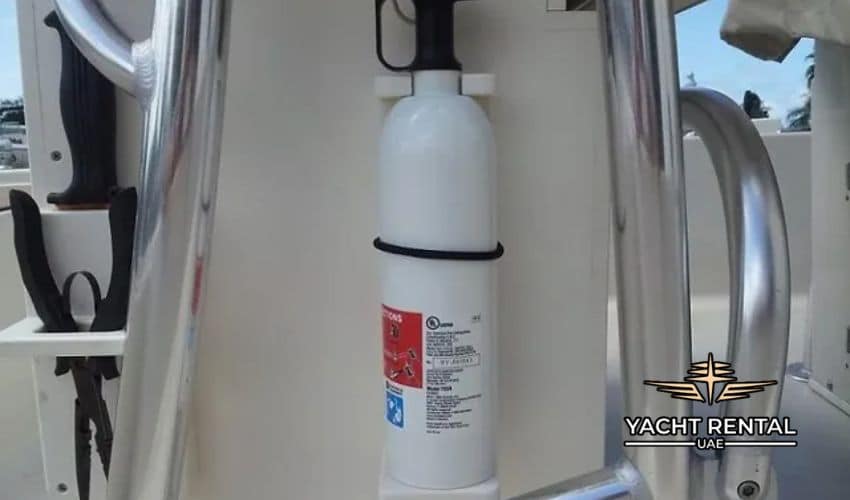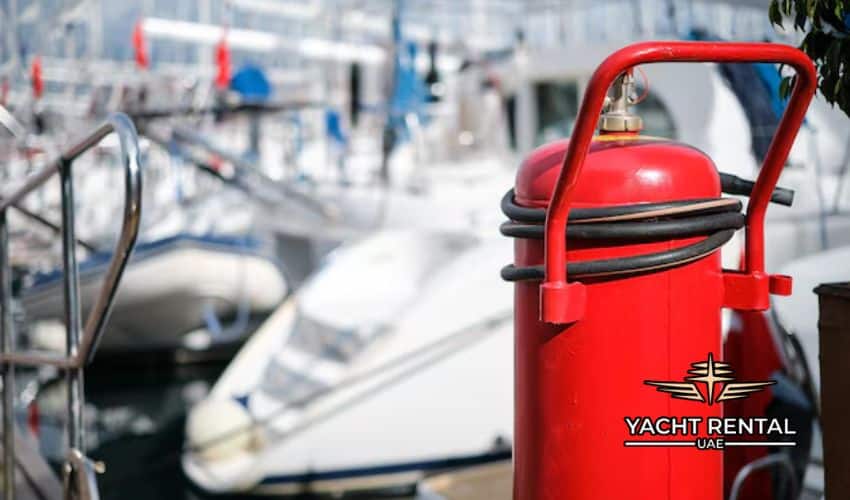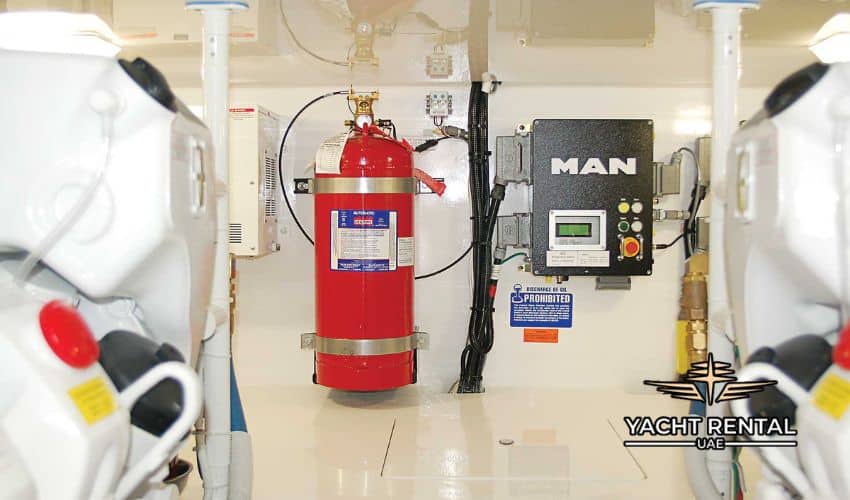Types of Fire Extinguishers for Boats
| Fire Extinguisher Type | Suitable for | Recommended Locations |
| Class A | Ordinary combustibles (wood, paper) | Cabin, living quarters |
| Class B | Flammable liquids (gasoline, oil) | Kitchen (galley), near fuel storage |
| Class C | Electrical fires | Bilge, areas with electrical equipment |
| Multi-purpose ABC | Combines A, B, and C types | Throughout the boat, for overall safety |
Ideal Locations for Storing Fire Extinguishers

Where to Store a Fire Extinguisher on a Boat? It is an important question asked by boat and yacht owners. Whether you drive your boat in the river or use your yacht for charter, you must know where to place the fire extinguishers for safety purposes. The ideal locations are:
- Cabin
- Kitchen
- Bilge
- Engine Room
Cabin
The cabin is a boat or yacht’s main living and sleeping area. Given its use and importance, having a fire extinguisher here is crucial. In case of a fire, easy access to an extinguisher can save lives and minimize damage. The extinguisher should be mounted near the entrance to ensure it is accessible when needed. Keeping a Class A or ABC extinguisher here is ideal for dealing with fires involving ordinary combustibles like wood and fabric.
Kitchen
The kitchen, or galley, is a common area for flammable materials due to cooking activities. Fires can start quickly from grease, oil, or faulty appliances. Placing a Class B or ABC extinguisher here is essential to tackle flammable liquid fires effectively.
Ensure the extinguisher is mounted near the cooking area but not so close that it is difficult to reach in an emergency. On an explorer yacht, where extended voyages increase the likelihood of cooking fires, having a well-placed extinguisher in the galley is even more critical.
Bilge
The bilge is prone to electrical fires and equipment failures due to the presence of electrical components and confined spaces. A Class C or ABC extinguisher should be placed here to manage electrical fires. Mount the extinguisher securely to prevent it from moving with the boat’s motion and ensure it is easily accessible.
Engine Room
The engine room is a high-risk area for fuel-related fires. Fuel leaks or overheating engines can quickly ignite. A Class B or ABC extinguisher is recommended for this area to deal with flammable liquid fires. You should mount the extinguisher securely and place it in a spot you can reach quickly, even in a tight space.
How To Install / Mount a Fire Extinguisher on a Boat?

Place fire extinguishers in locations where they are easily visible. Likewise, you must access them easily during an emergency. Avoid hiding them behind doors or inside cabinets. Mount fire extinguishers upright to prevent the chemicals inside from settling. This ensures the extinguisher works properly when needed.
In addition, adhere to all regulations regarding the mounting height and securing brackets of fire extinguishers. Typically, extinguishers should be mounted so that they are readily accessible but out of the way of normal activities. Regularly inspect fire extinguisher locations for obstructions. Ensure that nothing blocks access and that the extinguishers remain visible and accessible.
How to Use a Fire Extinguisher: The PASS Method
Using the PASS method, here are the steps to use a fire extinguisher on a boat or yacht.
Step 1: Pull the Pin
The pin is at the top of the extinguisher. Pull it to break the tamper seal. So this allows for the discharging of the extinguisher.
Step 2: Aim the Nozzle
Aim the nozzle at the base of the fire. Targeting the base helps to extinguish the fuel source of the fire.
Step 3: Squeeze the Handle
The next step is to squeeze the handle. Remember, do this carefully because it will release the extinguishing agent. Apply steady and even pressure to ensure a consistent flow.
Step 4: Sweep from Side to Side
Sweep the nozzle from side to side across the base of the fire until it is completely extinguished. Continue this motion until the fire is out, and keep an eye on the area to ensure it doesn’t reignite.
Maintenance and Safety Checks

Regular maintenance is essential to ensure fire extinguishers are in working order. Monthly inspections for pressure, seals, and hoses are critical. Annual professional maintenance is recommended to ensure everything meets safety standards. Replace extinguishers according to the manufacturer’s expiration dates.
Monthly Inspections
Carefully check the pressure gauge to confirm it is in the operable range. Examine the seals and hoses for any signs of wear or damage. For different types of yachts and sailboats, accessibility and visibility are crucial in performing these checks effectively.
Annual Professional Maintenance
Have a certified professional service your fire extinguishers yearly. This includes checking internal components and ensuring compliance with regulations. For larger yachts, yacht size dictates the number of extinguishers, making professional maintenance even more vital.
Replacement of Extinguishers
Replace fire extinguishers based on the manufacturer’s expiration dates, typically every 5 to 15 years. Old extinguishers can fail during an emergency, so timely replacement is crucial. Ensure to check the dates regularly and keep a log for reference.
Final Words About Fire Extinguishers Storage on the Boat
Proper placement and maintenance of fire extinguishers on a boat are crucial for safety. Ensure they are visible, easily accessible, and appropriate for different fire types. Regular inspections, repairs, overhauls, and maintenance are essential to keep them in optimal working condition.




